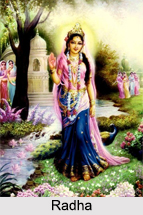 Radha has been depicted as part of Vaishnava tradition in Bhagavata Purana and Geet Govinda. She features prominently within the theology of today"s Gaudiya Vaishnava sect, which regards Radha as Shakti. Radha is an incarnation of Goddess Lakshmi and is also called Radhika, Radharani and Radhe. She is a Hindu goddess popular in Vaishnavism tradition.
Radha has been depicted as part of Vaishnava tradition in Bhagavata Purana and Geet Govinda. She features prominently within the theology of today"s Gaudiya Vaishnava sect, which regards Radha as Shakti. Radha is an incarnation of Goddess Lakshmi and is also called Radhika, Radharani and Radhe. She is a Hindu goddess popular in Vaishnavism tradition.
Etymology of Radha
The term Radha means "affluence and successes". It is founded in various contexts in the ancient and medieval texts of India. The term Radha also means "kindness, achievement and wealth". The word appears in Vedic literature as well as the epics.
Birth of Radha
Radha was the daughter of Vrishbhanu. Vrishbhanu was King Suchandra in his previous life. Suchandra and his wife had acquired a boon from Lord Brahma that in the Dwapar yuga Goddess Lakshmi would born as a daughter to them in form of Radha. Hence King Suchendra and Queen Kalavati were reborn as Vrishbhanu and Kirtikumari in the Dwapara Yuga. Radha"s birthplace is Rawal, a small village around 10 kilometres away from Mathura.
It is believed that one day Vrishbhanu was bathing in a river when he saw a lotus which had thousands of petals and it looked like golden lotus in the light of sun. When it came closer, he saw a small baby girl inside that flower. He wanted a baby girl so took her and brought her up as his own daughter. It is said that Radha didn"t open her eyes till she beheld the face of Krishna. After eleven months, when Vrishbhanu with his family went to Gokul to see Krishna then Radha opened her eyes for the first time and she saw Krishna.
Legends of Radha
 The first time when Radha is revealed in the texts is when Jayadeva wrote about her in "Geet Govinda" and also when "Nimbaarka" division started to speak about her. Before this era, Radha was not worshipped with Krishna in any temple. She was a village cow girl who lived only for Krishna and was dedicated to Krishna. Few kilometres away from Barsana, Uttar Pradesh (Vrishbhanu"s residence) is Gahvar forest where she used to meet Krishna. Vrindavan is the place where Krishna and Radha performed many raslila on the banks of Yamuna with the other gopis.
The first time when Radha is revealed in the texts is when Jayadeva wrote about her in "Geet Govinda" and also when "Nimbaarka" division started to speak about her. Before this era, Radha was not worshipped with Krishna in any temple. She was a village cow girl who lived only for Krishna and was dedicated to Krishna. Few kilometres away from Barsana, Uttar Pradesh (Vrishbhanu"s residence) is Gahvar forest where she used to meet Krishna. Vrindavan is the place where Krishna and Radha performed many raslila on the banks of Yamuna with the other gopis.
In Vaishnava traditions of Hinduism, Radha is Krishna`s friend and advisor. Other gopis are considered to be her maidservants. She is connected to Krishna in two ways: svakiya-rasa (married relationship) and parakiya-rasa (a relationship signified with eternal mental "love"). The Gaudiya Vaishnava tradition focuses on parakiya-rasa as the highest form of love, where Radha and Krishna share thoughts even through separation. She is worshipped in Vrindavan, the place where Krishna is said to have lived. In Gaudiya Vaishnavism, Radha`s love is considered as the most perfect because of its endless and unconditional nature.
One day Sudama, friend of Krishna went to meet Krishna but Radha stopped him. Angry Sudama cursed Radha that she would be forced to take birth in the earthly appearance on earth and she will have to accept the pain of separation from Krishna. The doomed day arrived and Krishna left for Mathura. She used to ask everyone where Krishna was. Once all the Gopis went to Kurukshetra for a sacred bath on the time of solar eclipse and Krishna was also there with his gopis. Krishna and Radha were face to face with each other but didn"t say a word to each other. Radha"s immense love and dedication towards lord Krishna got her this position, which she truly deserves. Radha is the heavenly queen of Krishna"s celestial world.
Temples of Radha
Some important Radha temples are as follows:
•Radhavallabh Temple (Mathura)
•Sri Sri Radha Parthasarathi Mandir (Mathura)
•Radha Krishna Temple (Delhi)
•ISKCON Radha Govinda Temple (West Bengal)
•Radha Gopinath Mandir (Uttar Pradesh)
•Sri Radha Damodar Mandir (Uttar Pradesh)
•Shree Radha Krishna Mandir (Mumbai)
Radha represents the true devotee, both in the form of male and female. Radha is sometimes considered as the incarnation of Goddess Lakshmi, the consort of Lord Vishnu.









